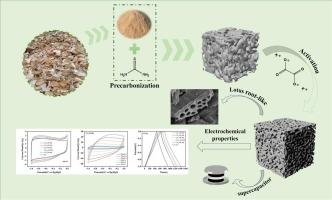S/N/O co-doped lotus root-like porous carbon with high microporosity for aqueous supercapacitors
IF 5.9
3区 工程技术
Q1 CHEMISTRY, MULTIDISCIPLINARY
Journal of Industrial and Engineering Chemistry
Pub Date : 2025-05-23
DOI:10.1016/j.jiec.2025.05.038
引用次数: 0
Abstract
The superior pore structure is essential for improving the charge storage capacity of capacitive carbon, in which micropores mainly provide charge adsorption sites and play a key role in enhancing the electrochemical properties. In this work, S/N/O co-doped biocarbon with a unique lotus-root-like structure and abundant micropores was prepared by two-step pyrolysis using pine sawdust, a typical forestry waste, as the raw material, thiourea as a pore expander and dopant, which expanded the role of K2C2O4·H2O as an activator. The maximum specific surface area(SSA) of the materials is as high as 2215 m2 g−1, and the best sample has the largest mass specific capacitance (320.15F g−1) as well as the best ultra-high microporosity (93.29 %). The assembled aqueous supercapacitor button type device possessed a coulomb efficiency of 99.97 % and capacity retention of 94.15 % after 20,000 cycles, indicating its extraordinary cycling stability. This study provides a feasible path for the resourceful treatment of forestry waste and the preparation of microporous-rich materials.

水溶性超级电容器用高微孔率的S/N/O共掺杂藕状多孔碳
优越的孔隙结构是提高电容性碳电荷存储能力的关键,其中微孔主要提供电荷吸附位点,对提高电容性碳的电化学性能起着关键作用。本研究以典型林业废弃物松木木屑为原料,以硫脲为扩孔剂和掺杂剂,通过两步热解法制备了具有独特藕状结构和丰富微孔的S/N/O共掺杂生物炭,扩大了K2C2O4·H2O的活化剂作用。材料的最大比表面积(SSA)高达2215 m2 g−1,最佳样品具有最大的质量比电容(320.15F g−1)和最佳的超高微孔隙率(93.29%)。组装后的水性超级电容器钮扣式装置在2万次循环后库仑效率为99.97%,容量保持率为94.15%,具有良好的循环稳定性。本研究为林业废弃物资源化处理和富微孔材料的制备提供了可行的途径。
本文章由计算机程序翻译,如有差异,请以英文原文为准。
求助全文
约1分钟内获得全文
求助全文
来源期刊
CiteScore
10.40
自引率
6.60%
发文量
639
审稿时长
29 days
期刊介绍:
Journal of Industrial and Engineering Chemistry is published monthly in English by the Korean Society of Industrial and Engineering Chemistry. JIEC brings together multidisciplinary interests in one journal and is to disseminate information on all aspects of research and development in industrial and engineering chemistry. Contributions in the form of research articles, short communications, notes and reviews are considered for publication. The editors welcome original contributions that have not been and are not to be published elsewhere. Instruction to authors and a manuscript submissions form are printed at the end of each issue. Bulk reprints of individual articles can be ordered. This publication is partially supported by Korea Research Foundation and the Korean Federation of Science and Technology Societies.

 求助内容:
求助内容: 应助结果提醒方式:
应助结果提醒方式:


